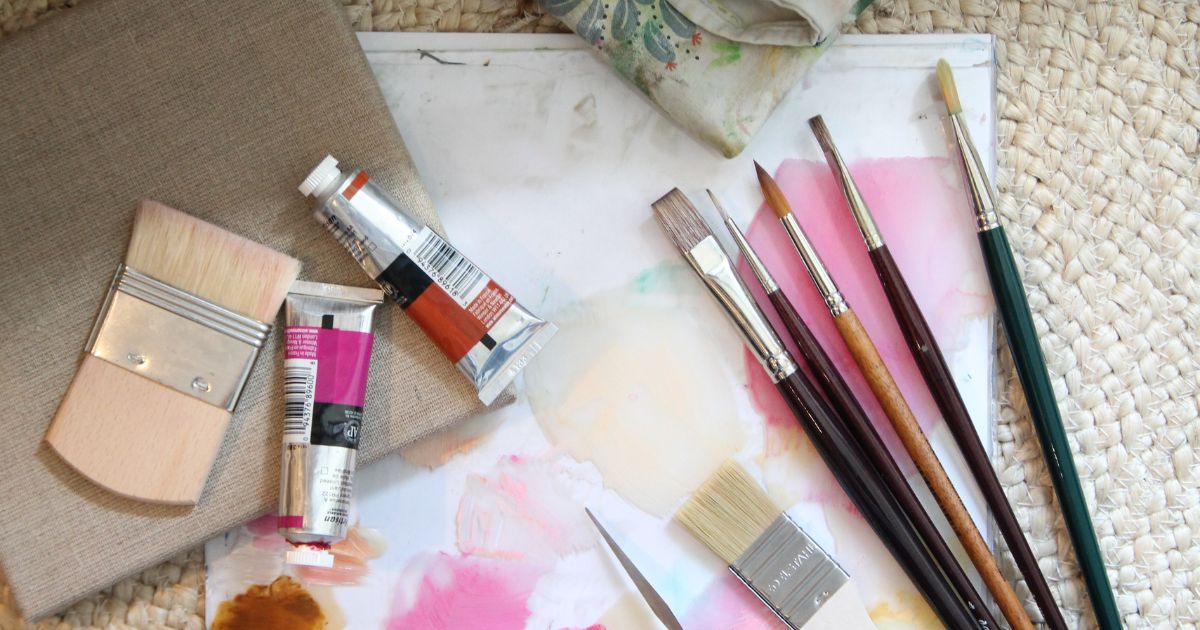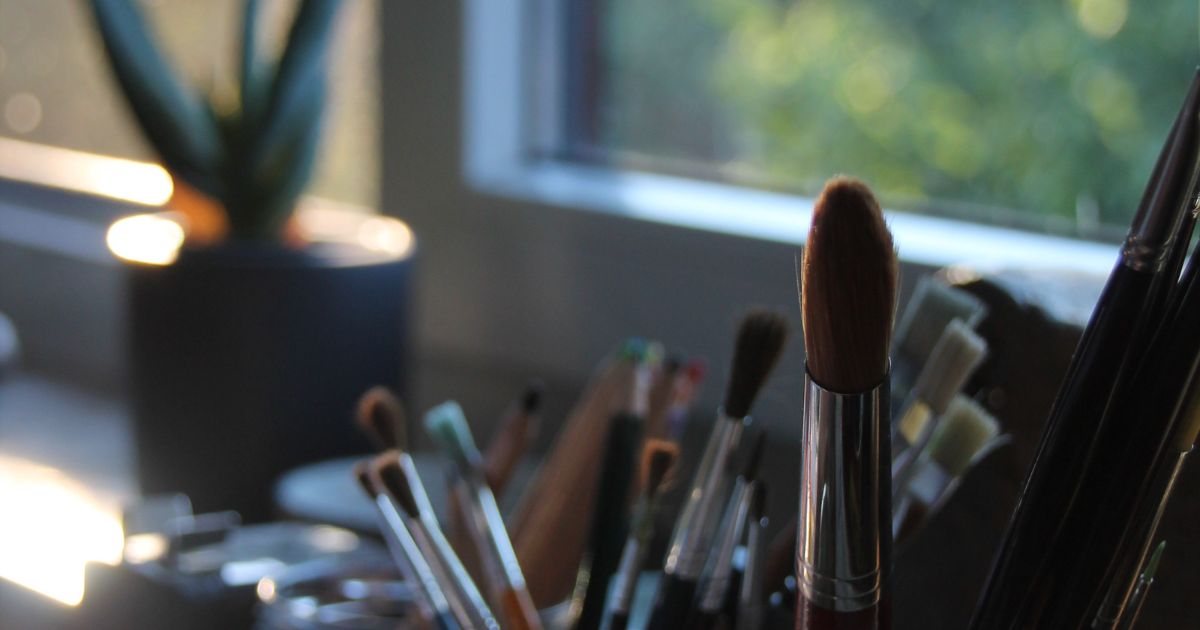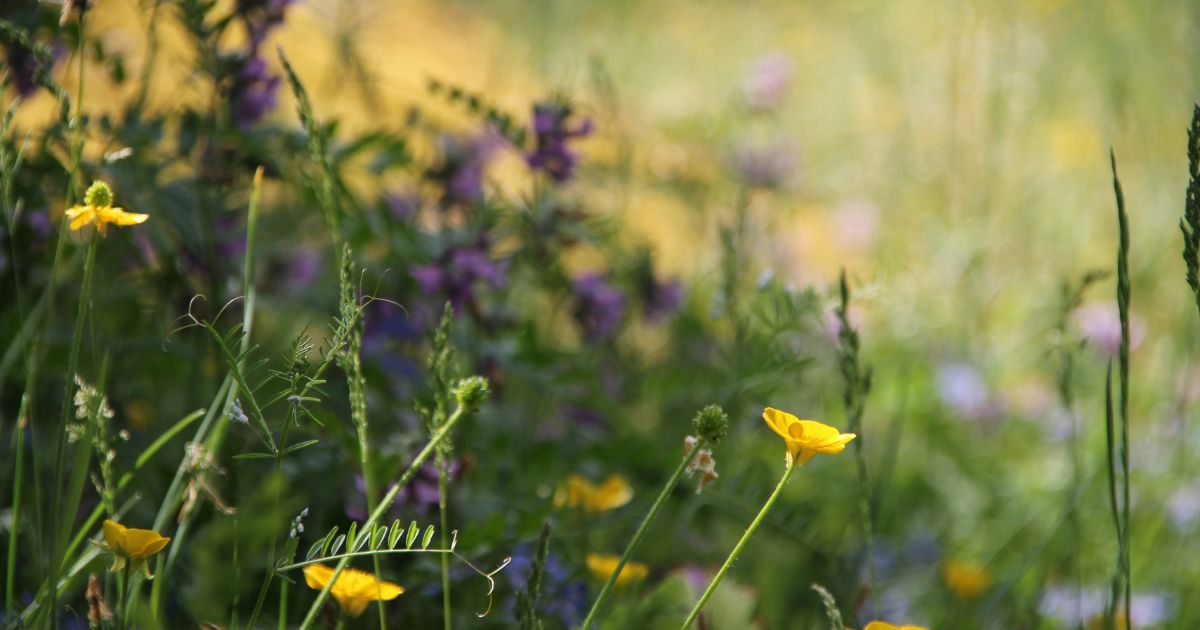When I first started to paint with oils, I was overwhelmed by the number of tools you might need or not. I watched YouTube videos, read blog posts, bought books about oil painting for beginners and even downloaded various resource guides, most of them filled with longish lists of brushes and paints and other things you “need”. And as I’ve also been on a tight budget, anything highly expensive just wasn’t realistic. Meanwhile, I also wanted to have an eco-friendly and non-toxic oil painting kit, which made things even more difficult. For this reason, I prepared for you my eco-friendly, non-toxic oil painting resource guide, to master building your own tiny-studio x sustainability x oil painting kit.
The Tiny Home Studio
First of all, my “art studio” is in my living room. It’s a tiny niche behind our couch that I changed into an art studio space. It’s all the space I’ve got for creating art. This tiny space limits me when it comes to the size of my artworks, as I can’t create paintings bigger than about 100 x 100 cm. However, this is fine for me, because right now I feel most comfortable creating small to medium sized artworks.
Now let’s dive into this oil painting resource guide, to prepare you with some great eco-friendly and non-toxic options (and get you painting as soon as possible!)
Let’s go shopping! … No, wait a second.
So, before you start shopping, think at least for a short time about the space available to you. Everything that starts with a tiny desk is fine, as you can very well paint smaller medium sized paintings with a table easel or lying down flat. Though, if you would like to go bigger, consider the space you need. The bigger the painting the more space you also need for yourself, because you will start moving around, make bigger moves with your arms or go backwards to have an overall look on your painting.
Also, consider that oil paintings take a while to dry, also in between painting sessions. As long as you aren’t only working on one painting at a time, you will need extra space to store it to dry. I simply hang them in my home, but if that’s not possible for you, also think about a drying spot.
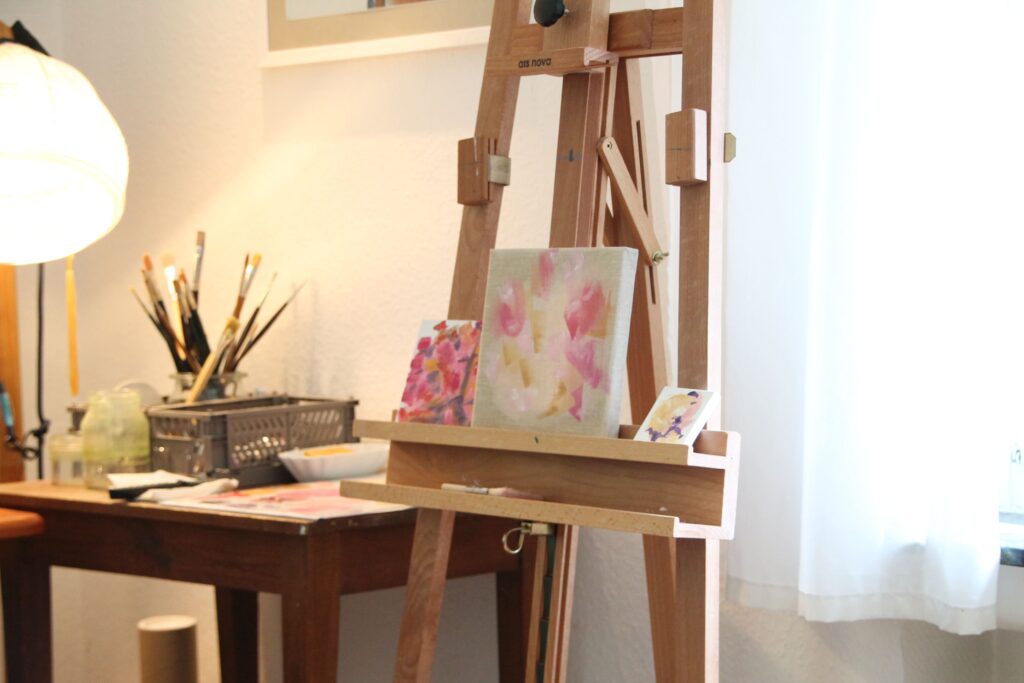
Pro Tip for working on an easel or flat on the ground at home: You would want to protect the floor in your home, as you won’t be able to scratch the oil paint off. I bought a sisal rug for under my easel (any rug will be fine), but a vinyl flooring also works pretty well.
I also wrote this very helpful, fully stacked blog post about how to set up an eco-friendly art studio, with many ideas, so feel free to read on over there as well.
Do I need an easel for oil painting?
It depends, but actually no. When you start oil painting and aren’t sure if it is for you, don’t buy an easel (though it looks pretty). You can also paint on flat lying canvas to start, and some artists even prefer this. An easel is only very helpful, if you paint on medium to big sized paintings, though many abstract painters prefer to paint on the ground. On flat lying canvas the paint wouldn’t run down and create drips, which makes handling the paint in the beginning a bit easier.
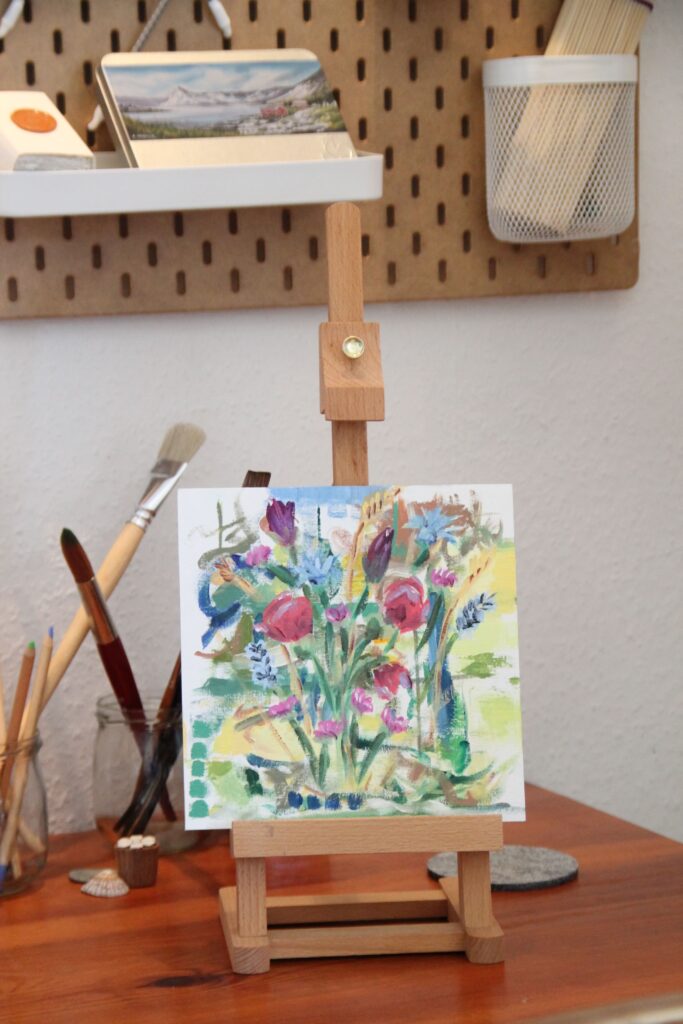
However, if you want to have an easel for whatever reason, here are two more tips:
- Consider a good quality table easel if you don’t have a lot of space and could work on a desk.
- DON’T buy the cheapest easel available. You will be annoyed. I know it’s difficult when you’re on a budget, but don’t buy an easel that you don’t feel well with. By the way, I wouldn’t have been able to buy my pretty easel without it being discounted, which I was very happy about. So also look for discounts or buy them second hand.
Anyway, you don’t need an easel as an oil painting beginner. But it’s nice to have one. I have a standing easel and a tiny table easel, which I use to store oil paintings while drying.
Eco-friendly Canvas for Oil Painting
Sustainability and creating art don’t go as well with each other, as you might have expected. For oil painting specifically, as a beginner, you will probably go for canvas at first, but you can also paint on wood panel, canvas stretched board or glass. Depending on what you want to achieve, I have several options for you.
1. On a tight budget:
Buy canvas stretched board. It’s often much cheaper, but you can paint great on it, and it doesn’t need much space as well. Though you will have to live with it not being as much eco-friendly. Being on a budget will often prevent us from more expensive and therefore more eco-friendly options in art, but that’s fine.
2. Medium Sustainable
That’s my solution right now and I’m very happy about it. I buy stretched and gessoed canvas, but I take care to only buy linen canvas and not cotton canvas. The production of linen is less polluting, needs less water and is therefore more eco-friendly. Linen is also produced in many European countries, so it’s also produced locally (at least I hope so, sadly there are no labels on any art products), which means the working conditions are much better. Whereas the conventional cotton production needs lots of resources, is polluting due to the pesticides and chemicals used in the production process and often comes along with poor working conditions and social injustice. I would buy biological cotton canvas, but as long as there are no labels and you can’t see where the canvas is produced, I won’t buy it.
Sadly, there no labels or further information on any art products, so you’ll never know for sure how they’ve been produced.
The compromise you’ll have to face in this option is buying pre-gessoed / primed canvas. Priming raw canvas is time consuming and takes some knowledge, which I, as a beginner, didn’t want to learn as well for now. Oil painting itself is a huge journey and you have to pick your battles.
What’s less eco-friendly about gesso, you might ask. Well, most common gesso is made of mineral oils and polymers, what basically means plastic. It’s what you want to avoid for sustainability reasons. Also, for traditional gesso, rabbit skin glue is needed (I didn’t want to read into it, honestly, because I find it disgusting) and some companies still use it. Because Tradition, you know … For now, I’m fine with this compromise, not knowing what kind of gesso sticks to my canvas, but I know, one day I’ll switch to option THREE.
3. Most eco-friendly, most expensive.
As written in Option Two, buy raw linen or hemp canvas and gesso it yourself. Then you have the fullest control over you’re medium. However, finding an eco-friendly gesso is … difficult. The only vegan, eco-friendly gesso I know about is from Natural Earth Paint (no affiliate link).
Why can’t I just paint on raw canvas?
Raw canvas might, for example, soak up the oil in your paint and leave the pigment on the canvas. When it dries, it might ruin the canvas, or your painting might not be long lasting. In combination with the air and sun, the oil will also harm the material further, as it acts corrosive, which you don’t want. Also, it makes the painting process much harder.
Which oil paint is the right one for beginners.
For oil painting beginners and at-home-studio owners, I would suggest buying water-soluble oil paints (I use Winsor & Newtons Artisan Oil Paint). They are healthier, as you only need water and oil to mix them and no turpentine or equally toxic binder. Also, they don’t emit fumes, harming your lungs.
Anyway, the most eco-friendly and healthy version would be to buy pure oil colours, only containing organic or laboratory pigments and oil, which are highly expensive. Additionally, the additives for example from Chelsea Classic Studio or Senneliers Green for Oils products are said to work very well. When it comes to sustainability, pigments are a case of themselves, as they need to be sourced somewhere in the world, which might destroy the local environment and harm people, but again, most companies won’t tell you where they source their pigments.
Hues and Gloves
Oil painting can be very toxic and health damaging if done careless and lightheaded. Many of the old artists suffered with health issues due to their paint’s ingredients. So always consider Hues instead of the toxic originals. E.g.: Buy Cadmium Red Hue instead of Cadmium Red. It means that it is a pigment that looks (almost) like the original but is non-toxic. And never by Lead White. Just go with Titanium white.
Besides, if you know you have sensitive skin, or know your immune system is low, have health issues or little cuts on your hands: Wear gloves. It won’t be sustainable wearing disposable gloves, but it will help your health, which is also a way of treating your body sustainably.
Are you still with me? I hope so, because now comes our second most important tool in my oil painting resource guide – brushessss! We all love them (though they can be VERY expensive).
Finding Eco-Friendly Brushes & Palette Knives
Brushes are my Nr. One I’m-getting-outraged-about-it topic, because there is no way of making it truly eco-friendly and sustainable. Here are the facts:
Natural-hair Brushes vs. Synthetic Brushes
Natural-hair brushes: They could (!!) be sustainable under controlled conditions, as natural-hair brushes with a wooden stick could be decomposed, BUT right now there are no instances who control the process and therefore it’s very likely that animals are harmed or killed during the process. Artists love their weasel, squirrel, horse or hog brushes, which mostly come from China, Siberia or other far away regions. But as long as a brush factory doesn’t show me and prove that they’re not guilty of animal cruelty, I won’t buy them.
Synthetic brushes: Well, they’re made from mineral oils, and you just use them for a while and then throw them away without recycling – and probably recycling would be difficult due to the paint remaining in used brushes, but I’m not sure about that. However, no animals get harmed through them (except when they enter the ocean as micro-plastic), so I rather use synthetic brushes. While some artists say these brushes don’t work as well as natural-hair ones, I think they just haven’t tried a really good one or found a brand that works for them.


Oh and don’t, I mean DON’T, buy cheap brushes. They are not worth it. You also don’t need to buy the most expensive ones, but please don’t make the mistake to buy cheap ones. I did, because they came in a bundle and I thought I make a win, but now I only use them for photography. They lose so much hair I can’t paint with them. You never want bristles on your painting. It’s so annoying. Right now, my go to brush companies are DaVinci (for watercolour and oil) or Boesner Kolintik (German), but I will try some others like Lascaux soon. More expensive ones are from Rosemary Brushes or Tintoretto.
The Palette Knife
Just buy one or two. For a beginner, as long as you don’t want to paint with a palette knife, it’s enough to have one or two of these. I would recommend buying a longer one (about 7 cm) and a shorter one (3 or 3,5 cm). Practice mixing colours with them at first, so you learn how you have to move the knife and your hand for the result you’re looking for.
By the way, I hate using a palette knife, though it makes paint mixing so much easier than using a brush. But I always struggle and still smear colour everywhere, but it’s slowly getting better. However, I still admire artists who are able to actually paint / create an artwork just with palette knifes. Incredible! (check out Rebekah Burgess)
Which Palette to Buy – Easy!
NO, you don’t need a wooden palette that you can hold in your hand in the way that you envision the old masters did it. It might be uncomfortable and you can’t clean it, so you need to throw it away one day. You also don’t need to buy a fancy stone or glass palette. Behold! I have two VERY easy ways for you.
Glass Palette:
Do you have an old picture frame that you don’t use for whatever reason? Remove the glass, make sure it’s not acrylic glass, and use it as your palette. Don’t have one? Ask friends or family or visit the flea market / online second-hand shop and just buy a cheap picture frame. Size A4 or A3 works very well for small to medium sized paintings.
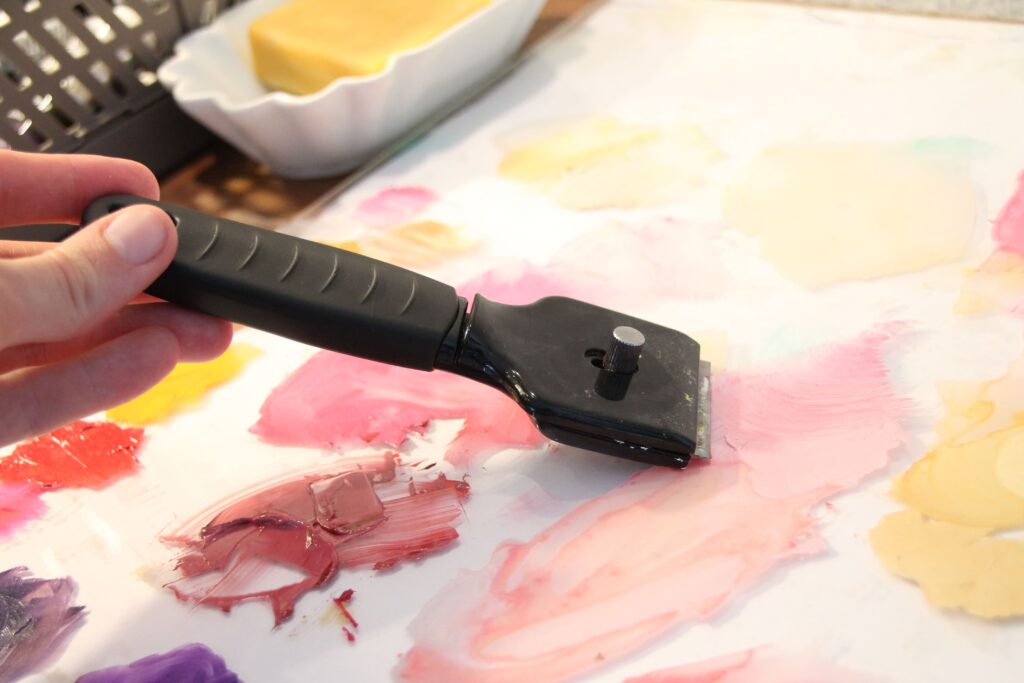
Stone Palette:
Visit a local kitchen studio or hardware store and ask for e.g. marble leftovers. When you cut countertops for kitchens you often have leftovers – kitchen sink! – which you can’t use. Ask if you can buy them or maybe get it for free.
Pro Tip: Clean your palette with a ceramic stove scraper. Leave your paint to dry on the palette and then just scratch it off.
Eco-friendly Oil Painting Kit – CHECK
That’s it. You don’t need much more to start painting with oils. I hope this loose resource guide helps you and you’ll start creating your first artwork soon! Make your art studio a healthy and eco-friendly space, so your creativity can spark and flow without you worrying about the environment or your health.

